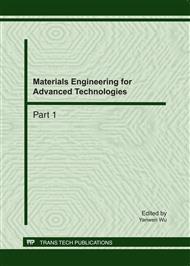p.246
p.250
p.256
p.261
p.266
p.272
p.278
p.283
p.288
Deep Analysis on Bioindustry Prospects of 40°С Volatiles of Cinnamomum camphora Branches
Abstract:
Cinnamomum camphora has been used to heal some specific diseases in the Chinese Folk for a long time. In order to explore the wide utilization in biomedicine and spicery, the chemical components of helium volatiles from the fresh branches of C. camphora were studied by TD-GC/MS. The analytical result by TD-GC/MS showed that 50 peaks were obtained from the helium volatiles from the fresh branches of C. camphora and 46 chemical compounds representing 99.993% of the total areas were identified. The results showed that the main components were as: Bicyclo[2.2.1]heptan-2-one, 1,7,7-trimethyl-, (1R)- (9.620%), 3-Cyclohexene-1- methanol, .alpha.,.alpha.4-trimethyl- (9.425%), 1,3-Benzodioxole, 5-(2-propenyl)- (8.223%), Bicyclo[2.2.1]heptane, 2-methyl-3-methylene-2-(4-methyl-3-pentenyl)-, (1S-exo)- (7.541%), Tricyclo[2.2.1.0(2,6)]heptane, 1,7-dimethyl-7-(4-methyl-3-pentenyl)-, (-)- (6.884%), Bicyclo[3.1.1] hept-2-ene, 2,6-dimethyl-6-(4-methyl-3-pentenyl)- (6.050%), Bicyclo[2.2.1]heptan-2-one, 1,7,7- trimethyl-, (1S)- (4.678%), 1,3-Benzodioxole, 5-(2-propenyl)- (4.500%), Naphthalene, 1,2,3,5,6,8a- hexahydro-4,7-dimethyl-1-(1-methylethyl)-, (1S-cis)- (4.491%), 3-Cyclohexen-1-ol, 4-methyl-1- (1-methylethyl)-, (R)- (4.254%), Copaene (4.120%), Tricyclo[2.2.1.0(2,6)]heptane, 1,7-dimethyl-7- (4-methyl-3-pentenyl)-, (-)- (4.097%), Acetic acid, 1,7,7-trimethyl-bicyclo[2.2.1]hept-2-yl ester (3.574%), Borneol 3.334%), 3-(4-N,N-Dimethylaminophenyl)propenoic acid, 2- (diethoxyphosphinyl)-, ethyl ester (2.809%), Eucalyptol (2.096%), 1,6,10-Dodecatriene, 7,11- dimethyl-3-methylene-, (Z)- (1.885%), (-)-Isosativene (1.664%), 1,6,10-Dodecatrien-3-ol, 3,7,11-trimethyl- (1.407%), Cyclohexene, 1-methyl-4-(5-methyl-1-methylene-4-hexenyl)-, (S)- (1.218%), 1,4-Methanoazulene, decahydro-4,8,8-trimethyl-9-methylene-, [1S-(1.alpha.,3a.beta., 4.alpha.,8a.beta.)]- (1.174%), .alpha.-Caryophyllene (1.156%), etc. The analytical result suggested that the helium volatiles from the fresh branches of C. camphora can be applicable to biomedicine and spicery industrial materials.
Info:
Periodical:
Pages:
266-271
Citation:
Online since:
June 2011
Authors:
Price:
Сopyright:
© 2011 Trans Tech Publications Ltd. All Rights Reserved
Share:
Citation:


